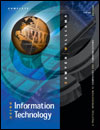Click-Along 9-2 (p. 371 Complete Version) Update: quality-of-life & economic issues As with nearly everything in information technology, the social and economics effects can sometimes change as rapidly as the hardware and software. This Click-Along updates some of the adverse effects described in Chapter 9. Environmental Problems: E-Waste Threatens Health & Environment
In a February 25, 2002, report, Exporting Harm: The High-Tech Trashing of Asia (see www.svtc.org), the Silicon Valley Toxics Coalition of San Jose, Calif., along with the Basel Action Network and other major nongovernmental organizations, reports on the effects of the global exporting of electronics waste, including computer monitors and circuit boards. The report says that 50%– 80% of the electronics waste collected for recycling in the United States is sent to China, India, Pakistan, or other developing countries, where valuable metals are extracted by primitive methods that are toxic to the workers involved and the environment. For instance, Chinese women, wearing no protective gear, use coal-fired grills to melt lead solder from circuit boards. Others smash lead-laced CRT monitors with hammers. (There are 2 to perhaps as much as 6 pounds of lead in average 18-inch TV sets and computer monitors.). Clouds of acrid gasses are given off. Remaining scrap is dumped into rivers and irrigation ditches, poisoning the groundwater. The irony, of course, is that much of this equipment gets to Asia by way of “recyclers” in the U.S., most of which are not capable of finding a new home for the donated equipment or of reducing it to usable material. Most recyclers remove selected items that are relatively modern and sell the rest for pennies to wholesale brokers. The Basel Action Network is a watchdog group that tries to enforce the 1989 Basel Convention, an international treaty intended to limit the export of hazardous waste and get developed nations to deal with the problems within their own borders. The United States is the only developed nation that has signed but not ratified the treaty. Most European countries have agreed to ban the export of hazardous wastes to poor countries, but not the United States. Electricity Consumption: Power Drains
Many electronic devices—PCs, TVs, VCRs, stereos, cable boxes—use power when they’re in standby mode or even when turned off. Energy leaked in this way accounts for 5%–10% of all residential electricity consumption in the United States, according to the Lawrence Berkeley National Laboratory. For instance, a personal computer will leak 14.9 kilowatts per hour of electricity every year—enough to power a 60-watt light bulb for 10.3 days. Internet Isolation
Although the evidence in the text would seem to have settled the question as to whether the online life leads to a lonely life, the Stanford University political scientist who touched off the controversy, Norman H. Nie, refuses to agree with critics that Internet interaction is its own form of human contact. In a book The Internet in Everyday Life, Nie and colleagues D. Sunshine Hillygus and Lutz Ebring report the findings a survey of how 6,000 Americans spend their time each day. Nie is still skeptical that the Internet increases the social contacts of its users. In his next study, he expects to show whether Internet users are happy, socially, adjusted, or depressed. Online Gambling
Online gambling sites exist in a gray area. Although illegal in the U.S., legal, licensed Internet casinos are located in places such as Antigua, Barbuda, Costa Rica, and Australia. Those sites and ads for them have grown significantly in recent years. Estimated online gambling revenues have gone from $1 billion in 1999 to $3.5 billion in 2002. More than 1,400 sports gaming sites have sprouted since 1995, attracting an estimated 5 million users, according to one New York market research firm. Although American law makes it illegal to place bets using phone lines (hence the Internet), hardly any bettors have been prosecuted. Despite the trends, however, credit card companies such as MasterCard and American Express are banning transactions at gambling sites. For experts on addiction, the biggest concern is that the convenience of online gambling—of being able to do it at a computer while in your pajamas—will remove some of the natural deterrents to what can be a devastating affliction. The Gap between Rich & Poor
It has been argued that a “digital divide” exists in which those with access to computers earned more than those without such access. In 1997, only 37% of people in families with incomes from $15,000 to $24,999 used computers at home or at work, according to the Census Bureau. By 2001, the proportion was 47%. Among those with incomes exceeding $75,000, the rise was from 81% to 88%, a more modest increase. During the second Bush administration, officials targeted some Clinton Administration programs aimed at reducing government-sponsored attempts to bridge the divide. Among the programs were tax incentives for companies bringing Internet access to poor and rural areas; the Education Department’s Community Technology Centers Program, which helped finance computer activity centers for students and adult education; and the Commerce Department’s Technology Opportunities Program, which provided money and services to organizations needing help with technology. Critics argued that half the new jobs for workers without college degrees require daily use of computers, often including use of the Internet, and that the income gap between workers who use computers and those who don’t is continuing to widen. One big difference, according to a 2002 Ford Foundation–financed report, Bringing a Nation Online: The Importance of Federal Leadership, is that more Americans with higher incomes use a computer at home (80% of those making $75,000 or more a year) compared with those with lower incomes (only 33% of those with incomes of $15,000 to $35,000). |




 2002 McGraw-Hill Higher Education
2002 McGraw-Hill Higher Education